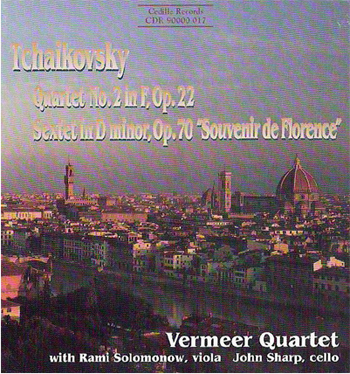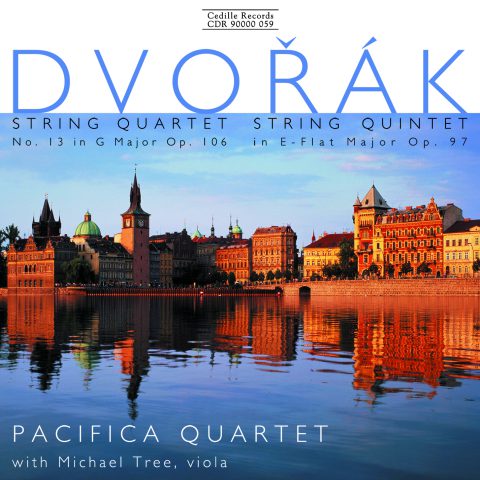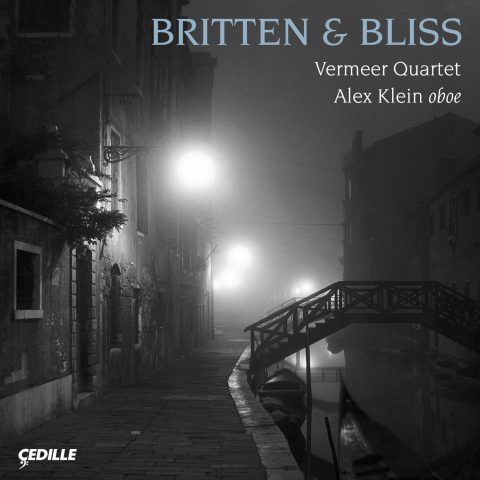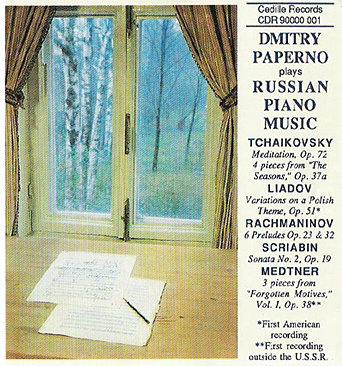Store
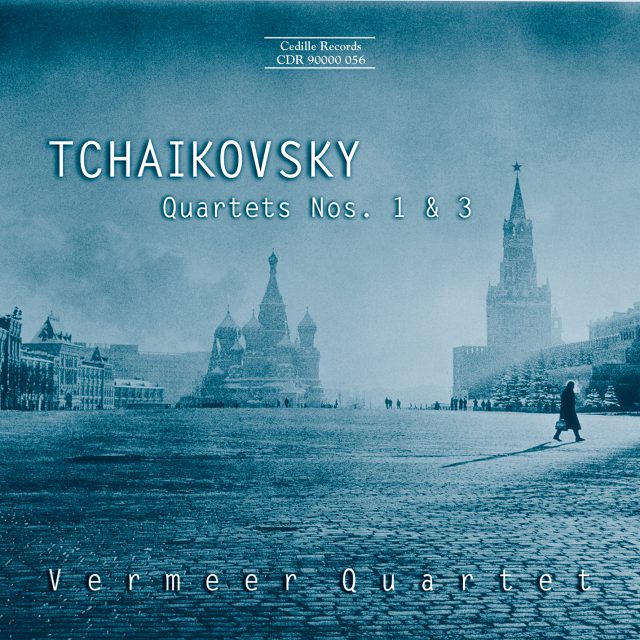
Store
Tchaikovsky: String Quartets Nos. 1 and 3
Formed at Marlboro in 1969, the revered Vermeer, “one of the world’s premier quartets” (Chicago Tribune), applies its characteristically “virtuous energy level” (Los Angeles Times) to Tchaikovsky’s much-favored First Quartet and his seldom-heard Third.
The famous “Andante cantabile” movement of the First Quartet ranges from moving melancholy to lyrical ecstasy. It’s said to have made Tolstoy cry, and gained such immediate popularity that Tchaikovsky worried it might overshadow the rest of his music.
An epitome of full-bore, heartfelt Romanticism, the rarely recorded Third Quartet is an elegiac tribute to a close friend. Especially eloquent and moving is its slow movement, marked “Andante funebre e doloroso.”
With this CD, the Vermeer concludes its survey of Tchaikovsky’s chamber works for strings, which began with Cedille Records’ 1994 release of the String Quartet No. 2 and string sextet, “Souvenir de Florence” (CDR 90000 017). The Chicago Tribune‘s John von Rhein called it “one of the most successful discs for [Cedille] to date” and praised the Vermeer’s “lean, sharply dramatic” interpretation. Terry Teachout of the New York Daily News gave it a four-star review for its “passionate, extroverted performances” and “beautifully recorded” sound.
Hear these vibrant Quartets played with the “edge that makes a Vermeer concert a dynamic experience” (Rocky Mountain News).
Preview Excerpts
PETER ILYICH TCHAIKOVSKY (1840-1893)
String Quartet No. 1 in D major, Op. 11
String Quartet No. 3 in E-flat major, Op. 30
Artists
Program Notes
Download Album BookletTchaikovsky: String Quartets Nos. 1 and 3
Notes by Andrea Lamoreaux
The frequency with which we hear the music of Peter Ilyich Tchaikovsky — in concert and on recordings — is the subject of much commentary. Such comments often rise to the status of complaints: a concert-goer exclaiming, “The Tchaikovsky Violin Concerto AGAIN?”, or a CD reviewer questioning the need for yet another recording of the Symphony No. 5, for example. Of course, Tchaikovsky’s mature symphonic masterpieces are among the most beautifully melodic and richly harmonized works in all the classical repertory; so they deserve to be played with great frequency. But there is another “Tchaikovsky” whose music one could never claim is overplayed.
In his relatively short lifetime of 53 years (1840- 1893), Tchaikovsky excelled at all the established musical genres of the 19th century — symphony, concerto, tone poem, opera, ballet, choral music, chamber music, solo piano, and song. Yet there is much that we rarely get to hear. For example, among his eleven full-length operas, only two are widely produced outside of Russia: Yevgeny Onegin and The Queen of Spades. And even the latter work, a musico-dramatic masterpiece by any standard, is still something of a novelty. (Lyric Opera of Chicago, one of the world’s major companies, presented it for the first time in the fall of 2000.)
The story is much the same with Tchaikovsky’s piano music, choral works, and songs. Though all are represented on recordings, they could enrich and vary concert programs and recitals to a much greater extent than they currently do. The Tchaikovsky chamber works heard most often are his Piano Trio in A Minor and the sextet subtitled Souvenir de Florence (the latter reflecting Tchaikovsky’s love for Italy along with his skill for creating lush string sonority). Considerably less familiar are the three works he wrote in the more common chamber conformation of the string quartet. With this CD the Vermeer Quartet joins a relative handful of ensembles that have recorded the entire set. (Quartet No. 2 is paired with Souvenir de Florence on Cedille Records CDR 90000 017.)
Unlike many great musicians, Tchaikovsky was not a child prodigy. Up to his early twenties he expected to take up a civil-service career. Fortunately, he found his calling when he began taking classes at the new music school Anton Rubinstein founded in St. Petersburg. After leaving the St. Petersburg Conservatory, he embarked on a three-fold career that involved teaching at the even newer conservatory of Moscow, writing music criticism, and composing. His string quartets all date from what might be called his first creative period: the late 1860s through early Seventies. Prominent pieces from those years include Romeo and Juliet, the first three symphonies, the B-Flat Minor Piano Concerto, and his first ballet, Swan Lake.
The works from this period were, for the most part, successful. They did not provide immediate financial security, however. Tchaikovsky’s life as a fulltime composer of independent means would not begin until 1876. That’s when Nadezhda von Meck, a wealthy, music-loving widow, took particular interest in The Tempest, a Shakespearean fantasy that followed Romeo and Juliet. The stipend she granted Tchaikovsky freed him from money worries and also led to an extraordinary exchange of letters in which the composer shared thoughts about his craft. This extract from a letter of March 1878 offers some revealing comments:
You ask how I manage my instrumentation. I never compose in the abstract; that is to say, the musical thought never appears otherwise than in a suitable external form. In this way I invent the musical idea and the instrumentation simultaneously. Thus I thought out the scherzo of [the Fourth Symphony] at the moment of its composition — exactly as you heard it. It is inconceivable except as pizzicato. Were it played with the bow, it would lose all its charm and be a mere body without a soul.
As regards the Russian element in my works, I may tell you that not infrequently I begin a composition with the intention of introducing some folk melody into it. Sometimes it comes of its own accord, unbidden . . . As to this national element in my work, its affinity with the folksongs in some of my melodies and harmonies comes from my having spent my childhood in the country and, from my earliest years, having been filled with the characteristic beauty of our Russian folk music. I am passionately fond of the national element in all its varied expressions. In short, I am Russian in the fullest sense of the word. (Composers on Music, Josiah Fisk, editor, Northwestern University Press, Boston, 1997)
Tchaikovsky’s cordial but arm’s-length relationship with Mme. von Meck (they never met) was still in the future in 1871, when Tchaikovsky decided to supplement his modest income from teaching and journalism by staging a concert of his own works in Moscow. This first-ever all-Tchaikovsky program featured some piano works, a group of songs, and a brand-new string quartet. The pianist was Nikolai Rubinstein, Tchaikovsky’s mentor at the Moscow Conservatory. The string players were members of the Russian Musical Society, led by another Moscow faculty member, eight years Tchaikovsky’s senior: violinist Ferdinand Laub.
Newspaper critic Herman Laroche raved, “Tchaikovsky’s compositions revealed a rich and sympathetic talent. The String Quartet was distinguished by the same delightfully succulent melodies, beautifully and interestingly harmonized, the same mobility of tone — so foreign to the commonplace — the same . . . softness, to which we have become accustomed in this gifted composer.” Those “rich melodies” appear from the outset of Tchaikovsky’s String Quartet No. 1 in D major, Op. 11. The first movement, marked Moderato e semplice, is a bit slower than most Classical-Romantic opening movements. Two themes, the second announced by the viola, intertwine and contrast throughout, accentuated by syncopated rhythms.
The second movement is an exception to the general observation that Tchaikovsky’s cham- ber music is not too well known. This is the famous Andante Cantabile that has been rearranged countless ways, and is probably one of the composer’s best-known pieces — except in its original form. It reflects the love of Russian folk music about which he wrote to Mme. von Meck. The main theme comes from a tune called “Vanya sat on the divan and smoked a pipe of tobacco” (or, in another translation, “Vanya one night sat sadly on the divan, a glass of rum in his hand, to drown his sorrow and forget tomorrow”). He heard and transcribed this tune while at his favorite country retreat, a family estate called Kamenka. All other themes in the quartet are the composer’s own, though some may also have been influenced by his affection for folksong. Like his Bohemian contemporary, Antonin Dvor˘ák, Tchaikovsky was usually not inclined toward direct quotations of folksongs; he preferred instead to compose new melodies that recall folk music without precisely emulating it.
The shortest movement of the D major Quartet is an intense and lively Scherzo. The Finale again reveals Tchaikovsky’s love for folk music. Each of its two main themes is reminiscent of folksong melodies. As with the first movement, Tchaikovsky spotlights the viola by having it introduce the second theme.
The concert that introduced the Quartet No. 1 was an unqualified success and gave the emerging composer some much-needed recognition. A touch of prestige was added by the attendance of Ivan Turgenev, the prominent 19thcentury Russian novelist. Another acclaimed novelist of the day also plays a part in the First Quartet’s history: Leo Tolstoy is said to have burst into tears when he first heard the Andante Cantabile. A thoroughly Romantic-era reaction, perhaps, but also a testament to the power of Tchaikovsky’s melodic gifts.
Tchaikovsky dedicated his String Quartet No. 3 in E-Flat minor, Op. 30 to the memory of Ferdinand Laub, who played first violin in the Russian Musical Society ensembles that premiered Tchaikovsky’s First and Second Quartets. Laub was born in Prague in 1832 and first appeared in public at the age of six. After a concert career that took him all over Europe (and partnered him with such luminaries as pianist Clara Schumann and soprano Adelina Patti), he settled in Moscow in 1866, to teach at the new conservatory and lead both orchestral concerts and chamber-music evenings. Friends and colleagues throughout the continent mourned Laub’s untimely death in March of 1875. His virtuoso performances included not only the standard concertos but also works by Bach, whose violin sonatas were not staple concert fare in that day.
Tchaikovsky’s Third Quartet was premiered in March of 1876 by the same group that had introduced the first two, but led by a new first violinist. Much of the Quartet was written on the road. Tchaikovsky was an enthusiastic traveler; even when he didn’t have much money for extended vacations, he would escape as often as he could to visit Italy, Switzerland, Germany, and France, sending letters home to his brothers and friends that often commented scathingly on poor hotels and uncongenial company. These are brightened, however, by his articulate descriptions of plays and concerts (he loved Bizet’s Carmen in Paris but disliked Wagner’s Ring in Bayreuth). In December 1875, he set out on one of his Western European sojourns accompanied by his brother Modest, the family member to whom he felt the closest, and probably his best friend. (It was Modest who, many years later, suggested the singularly appropriate subtitle of Pathétique for the Symphony No. 6.) Tchaikovsky composed most of the Third String Quartet during the brothers’ stays in Berlin, Geneva, and Paris; then completed it back home in time for the 1876 premiere. It was repeated several times in quick succession immediately following its premiere. Its first listeners were all especially touched by the third movement, marked Andante funebre e doloroso ma con moto.
In the 1930s reference book, The Victor Book of the Symphony, Charles O’Connell’s commentary on Tchaikovsky’s Fifth Symphony contains words applicable to so many works, including his Third Quartet:
Tchaikovsky alone of all the great composers seemed to have fully understood, and to have given most eloquent expression to, melancholy’s sad and mystical loveliness. Purified of ugliness and hatefulness in the marvelous [medium] of his music, it is not the dull gloom that weighs down a soul by sheer oppressiveness; rather, it glows, darkly and richly.
The quartet opens Andante sostenuto in the manner of a dirge, followed by a livelier Allegro moderato, and a return of the sustained theme. This opening movement is vastly more expansive and more formally complex than those of the First and Second Quartets. The main theme of the Andante portion offers the first indication that this piece is Tchaikovsky’s memorial to his friend. Marked Cantabile e molto espressivo, the mournful yet lyrical theme is presented by the first violin over pizzicatos from the other players. Two contrasting themes are set out in the Allegro, followed by an intricate development that closely intertwines the performers in heartfelt expressiveness. After the recapitulation of the Allegro that’s standard in first-movement sonata form, Tchaikovsky also recapitulates the theme of the Andante, creating a symmetry that gives the long movement the feel of a complete work.
The Scherzo comes in second place, not the usual third. The agitation of its moods provides a kind of anticipation of the heartfelt grief expressed in the ensuing Andante: like the nervous pacing up and down of a hospital corridor proceeding the measured tread of a funeral procession. The Andante movement is interrupted and ended by somber, (literally) muted chords that recall the deep, austere chants of Russian church music. Surrounding these passages are melancholic themes that reflect the composer’s very personal grief over his friend’s death. In stark contrast to the preceding sadness, the upbeat Finale contains hints of folksong, but also a brief recollection of the Andante, as if to cast shadow on sunlight
Album Details
Total Time: 67:15
Recorded: October 1999 & May 2000 at WFMT Chicago, Illinois
Producer: James Ginsburg
Engineer: Bill Maylone
Cover: Red Square, Moscow. Photo © Adri Berger/Stone
Design: Melanie Germond
Notes: Andrea Lamoreaux
© 2001 Cedille Records/Cedille Chicago
CDR 90000 056
